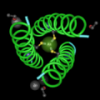Note to self: doing live BLAST searches during a lecture is not a good idea.
Would Julia Child make her viewers watch the food bake?
Standing in front of a class and waiting for results to appear, makes me realize how much instructors can learn a lot from watching Julia Child demonstrate cooking. I think if Julia Child taught bioinformatics this is how she would discuss BLAST results with her class:
Afer a BLAST search has been submitted to the NCBI, your results are stored there for 24 hours, and you can get them with the request ID. If you do searches ahead of time and save the request IDs you can use them during class to get your results.
- 1. Copy the request ID. (paste it in a place where you can find it later)
- 2. Then, during your lecture, go to the NCBI BLAST home page.
- 3. Look in the cell at the bottom right corner. The cell is titled Meta. Click the link that says "Retrieve results."
- 4. Paste the request ID in the box. Change any filtering parameters.
- 5. Click the large Format button.



Much quicker!
And now we can happily chew on the fully baked results.
***Note: I updated this information to reflect the changes at the NCBI. *******

Beware: they only save those RIDs for a limited time. I think it's less than a week.
Yes that's true. They only save them for 24 hours.
Great tip...I have done too many live searches with my classes.